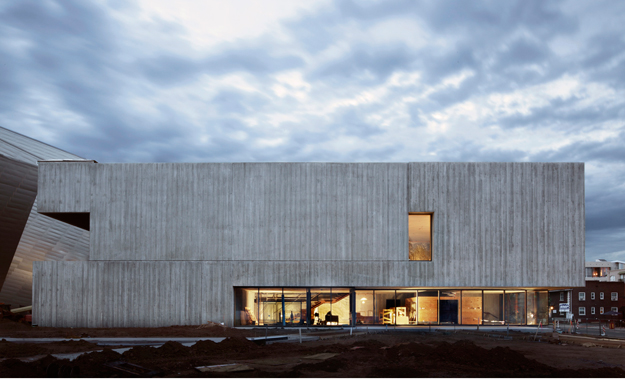Brad Cloepfil takes Architectural Record on a tour of his 'introverted' building'a $29 million project that exceeded his expectations.
 |
| Photo by Jeremy Bittermann/courtesy Clyfford Still Museum |
The new Clyfford Still Museum, by Allied Works, is located next to the Daniel Libeskind-designed Denver Art Museum. |

Brad Cloepfil walks through the second-floor galleries of Denver’s Clyfford Still Museum, taking it all in. It’s the first time the founding principal of Portland, Oregon-based Allied Works Architecture has seen his building since construction was completed, and clearly he likes what he sees. In a few weeks, the walls will be covered with Still’s paintings and drawings, in time for the museum’s November 18 opening. But for now, the building is empty, a blank slate. Cloepfil seems to relish the moment. Every now and then, he snaps a photo with his black Lumix camera.
“Wow,” he says. “It’s like seeing it for the first time. It’s done. It’s real. This is probably the first time in my career that a building is more than I imagined. Everything is better than I hoped for.”
The museum is a concrete box with textured exterior walls set in a tree-lined plaza. The $29 million, 28,500-square-foot structure sits directly adjacent to Daniel Libeskind’s flamboyant 2006 addition to the Denver Art Museum. That building, with its sharply angled titanium forms, seems to reach for the sky. Cloepfil’s two-story museum, by contrast, feels intimate and earthbound.
“Denver, contrary to what some people think, is a prairie town,” Cloepfil says. Pointing to the west, he says, “The mountains are way over there. I wanted this building to be grounded, part of the earth. This is a neighborhood with very aspirational, very bombastic, very extroverted buildings, and this is a very introverted project.” Cloepfil has said that he conceived of the building “as a nearly geologic experience, one that firmly holds both visitor and art in spaces amplified by natural light.”
Visitors enter the building by way of a cantilevered concrete canopy. Inside, the reception lobby is long and low, with a 10-foot ceiling. “There’s a sense of compression when people walk into the building,” Cloepfil says, “and then a release when they go upstairs to the galleries.” A wooden staircase leads to the second floor, which has nine galleries, some as high as 17 feet. Most have perforated concrete ceilings to allow Still’s paintings to be seen in natural light. Two outdoor corner terraces offer visitors “places of contemplation,” Cloepfil says.
Museum director Dean Sobel is pleased with Cloepfil’s design. “I think it does all of the things we wanted it to do,” he says. “The whole project was about finding that mix of architectural statement and backdrop for Still’s paintings, and I think Brad nailed it.”
Still was a leading abstract-expressionist painter whose contemporaries included Jackson Pollock, Franz Kline, and Robert Motherwell. But Still’s work isn’t as well known. He turned his back on the art world in the 1950s, cutting ties with commercial galleries, and he placed severe restrictions on how his paintings could be exhibited. When he died in 1980, more than 2,000 pieces of his art, comprising 94 percent of his total output, were locked away in storage.
Still’s will stipulated that his entire estate be given to an American city willing to build a museum devoted to his work. In 2004, Denver—which in recent years has sought to raise its cultural profile—convinced Still’s widow, Patricia, that it was up to the task. (Other cities had been unsuccessful in their lobbying efforts.) In 2006, Allied Works Architecture was chosen over Diller Scofidio + Renfro and Ohlhausen DuBois Architects to design the museum, which is operated as a nonprofit with an independent board of directors. Construction was funded through private donations.
In keeping with Still’s wishes, the museum does not have a restaurant or auditorium, and only works by Still can be displayed. The bulk of his artwork has not been seen by the public. Sobel hopes the institution will become a destination museum for lovers of modern art.
What would the famously cantankerous Still think of the new museum? Cloepfil laughs. “Oh, he would probably have endless complaints,” he says. “I’m sure he would be raging against the architect right now. But I think he might be the only one. I’m really happy about this building.”
Look for full coverage of the Clyfford Still Museum in a future issue of Architectural Record.

Post a comment to this article
Report Abusive Comment